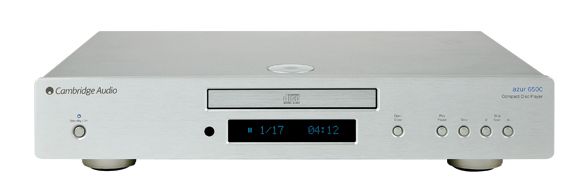Cambridge Audio 650c (£330)

Designed by The Audio Partnership in central London and manufactured in large volumes in the Far East for distribution worldwide (including an exclusive deal with Richer Sounds in the UK), Cambridge Audio products have become synonymous with good performance at a competitive price.
The Azur component range was revamped substantially a couple of years ago. Soon after its introduction we featured this Azur 650C player alongside its partnering 650A integrated amplifier in our Nov ’09 Group Test.
To recap, while a bit more expensive than the 640 models they replaced, they featured a fresh-up and wholly improved design with wrap-around casework and substantial alloy fascias that belied their (still modest) price tags. The power supply of the 650C employs a toroidal transformer, while its disc transport is coupled to what Cambridge calls its ‘S3 Custom CD Servo controller’.
It would be churlish to criticise anything about the package on offer here, given the price of the 650C. It comes with a sensibly designed remote handset and the player even displays CD Text. Strangely enough it’s the only player in this month’s group to include this functionality. Go figure…
BUDGET MARVEL
Just as it’s hard to criticise the build quality of the 650C, it’s also pretty darned difficult to fault its sound quality given its modest pretensions.
Alright, so with The Helicon Ensemble’s Vivaldi performance it was observed that the tonal palette was a little bleached, and the brittleness of their instruments rather ‘scratchy’ where the Marantz and Primare players managed to avoid edginess despite their vivid detail resolution. But the image perspective was wholly preserved – and I was listening to this budget-priced machine back-to-back against much costlier players, after all.
Heard in isolation I might not have noticed its slightly grainy high frequencies, especially since it sounded bold and full-bodied with the Pink Floyd track. Indeed, with Patricia Barber’s ‘Bye Bye Blackbird’ it offered amazing insight into the atmosphere of the performance, although the bass was looser and less well defined than via the Moon CD.5 for example, and the Marantz player was noticeably smoother and more refined.
It put on a good show with Adele’s ‘Rolling In The Deep’ as well. Its openness allowed the thumping drum plenty of space in which to breathe; the acoustic guitar chops sounded resonant and wholly believable through the high-end test system; and Adele’s vocal was tightly focused. The more costly players better ameliorated the sibilance of the cymbals, nevertheless this is a pretty good machine – it really is.
Originally published in the July 2011 issue

























































